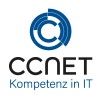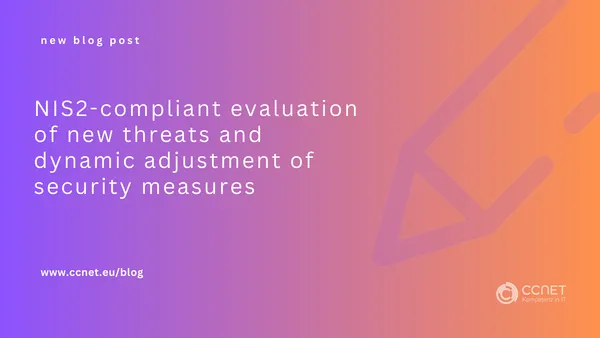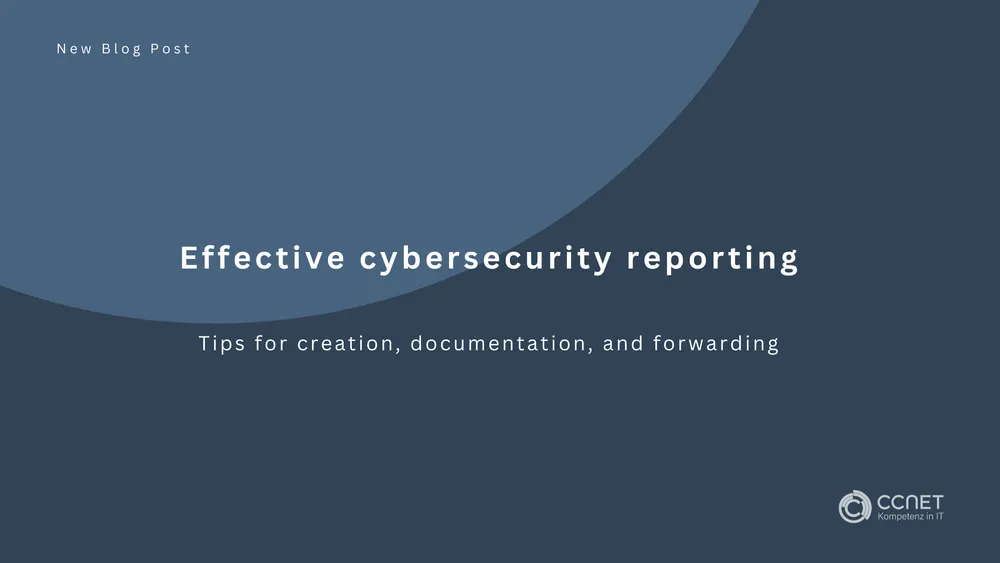
CCNet
Jan 3, 2025 • 3 min read

NIS2-Compliant Evaluation of New Threats and Dynamic Adjustment of Security Measures
A central component of a cybersecurity strategy in accordance with NIS2 is the ability to detect new threats early and respond quickly. A continuous threat intelligence program ensures that risks are proactively identified and security measures are adjusted promptly to protect a company’s IT infrastructure. This process ensures that companies are prepared for current and future cyber threats.
What You Need: An Effective Threat Intelligence Program
An effective program for evaluating threats must monitor all IT systems, networks, and applications within a company. It is important to identify new threats early, evaluate them, and implement appropriate security measures. Regular reporting and monitoring of these measures continuously improve the cybersecurity strategy.
How to Implement It: A Process for Evaluating and Adjusting Security Measures
-
Process Goal: Early Detection and Effective Risk Mitigation
- Objective: Continuous monitoring and evaluation of the threat landscape ensure that new risks are identified early and existing security measures are efficiently adjusted.
-
Process Scope: All IT Systems in Focus
- Scope: The process involves monitoring all IT systems, networks, and applications within the company. The focus is on evaluating new threats and promptly adjusting security measures to ensure the confidentiality, integrity, and availability of the IT infrastructure.
-
Frequency of Monitoring and Evaluation: Continuous and Up-to-Date
- Continuous Monitoring: The threat landscape is monitored around the clock. As soon as a new threat is detected, an immediate evaluation and adjustment of security measures take place.
- Monthly Reports: A report on the current threat landscape is created monthly, summarizing the identified threats and actions taken.
-
Process Steps: From Monitoring to Adjustment
-
4.1. Continuous Monitoring of the Threat Landscape
- Responsible: IT Security Officer and Threat Intelligence Team
- Activity: The threat landscape is continuously monitored using a threat intelligence program. This includes both external sources (e.g., security forums, intelligence services) and internal systems that are checked for new threats.
-
4.2. Identification and Classification of New Threats
- Responsible: Threat Intelligence Team
- Activity: When a new threat is detected, it is immediately classified by type, potential impact, and likelihood of occurrence. All threats are documented in an internal threat register.
-
4.3. Evaluation of the Threat
- Responsible: IT Security Officer and IT Team
- Activity: Identified threats are thoroughly evaluated to determine potential risks to the company’s infrastructure. This evaluation takes into account the impact on the confidentiality, integrity, and availability of IT systems.
-
4.4. Creation of a Threat Report
- Responsible: IT Security Officer
- Activity: After the evaluation, a detailed threat report is created. This report contains the results of the risk assessment as well as recommendations for risk mitigation measures and is presented to management.
-
4.5. Adjustment of Security Measures
- Responsible: IT Team
- Activity: Based on the threat report, existing security measures are adjusted. This may include the installation of new technologies, updating security protocols, or conducting employee training.
-
4.6. Review of Implemented Measures
- Responsible: IT Security Officer
- Activity: After the implementation of new security measures, their effectiveness is reviewed. The results are documented and adjusted if necessary.
-
4.7. Documentation and Reporting
- Responsible: IT Security Officer
- Activity: All steps, from identifying new threats to adjusting security measures, are documented. Monthly reports are created and provided to management and relevant stakeholders.
-
-
Roles and Responsibilities: Collaboration for Effective Security
- IT Security Officer: Responsible for initiating the threat intelligence program, evaluating threats, and creating reports.
- Threat Intelligence Team: Responsible for continuously monitoring the threat landscape and classifying new risks.
- IT Team: Responsible for implementing and reviewing new security measures.
- Management: Approves the proposed measures and provides the necessary resources.
-
Reporting: Regular Communication and Transparency
- Monthly Reports: A monthly report on the current threat landscape, identified risks, and actions taken is created. This report is forwarded to management and relevant stakeholders to ensure transparency.
-
Continuous Improvement: Adapting to Current Threats
- Activity: The process for evaluating new threats is regularly reviewed and improved to ensure it remains up-to-date with the threat landscape and technological developments. Adjustments to methodology and evaluation criteria are made as needed.
Benefits of Continuous Threat Evaluation
- Early Detection of New Threats: Continuous monitoring allows risks to be identified early and addressed more quickly.
- Flexibility and Adaptation: Immediate evaluations and adjustments to security measures ensure that the company stays up-to-date with the latest cybersecurity developments.
- Effective Risk Mitigation: Detailed reports and timely implementation of measures ensure comprehensive protection of the IT infrastructure.
Conclusion: Efficient Security Measures Through Continuous Threat Monitoring
By using a continuous threat intelligence program and flexibly adjusting security measures, a company can ensure that it is prepared for current and future threats. Regular evaluation and review of measures ensure that the IT infrastructure is optimally protected – in NIS2-Compliant alignment with the latest requirements. A Dynamic and proactive approach is the key to a secure digital business environment.


